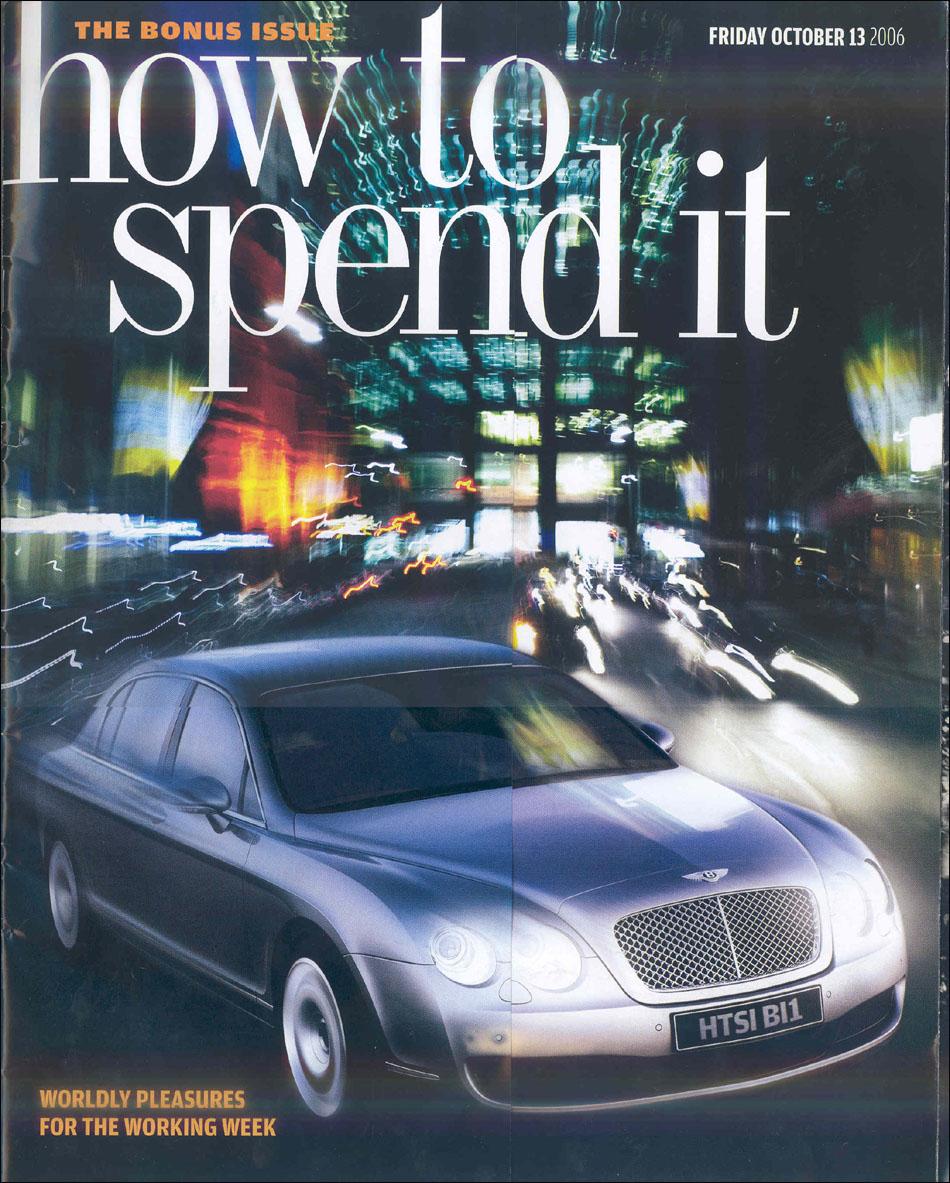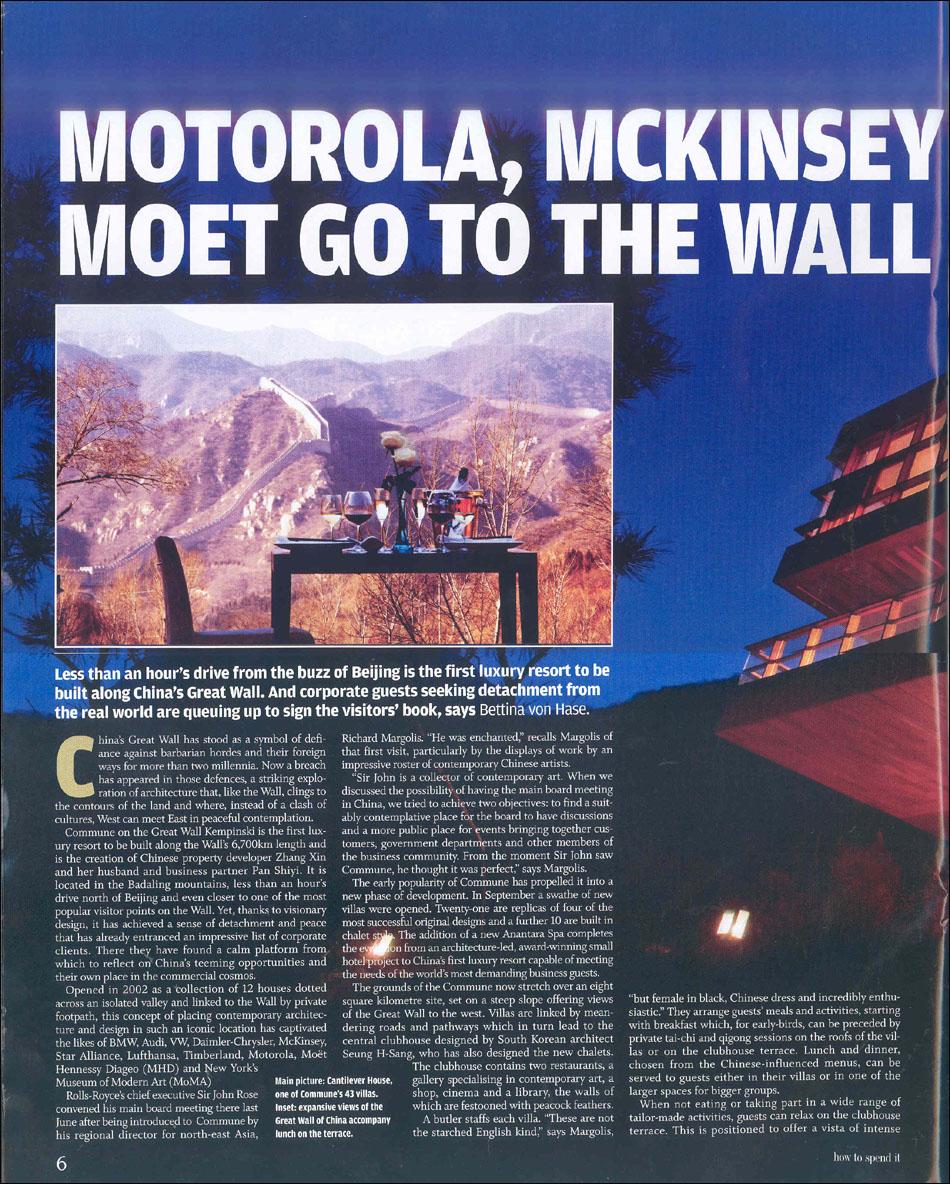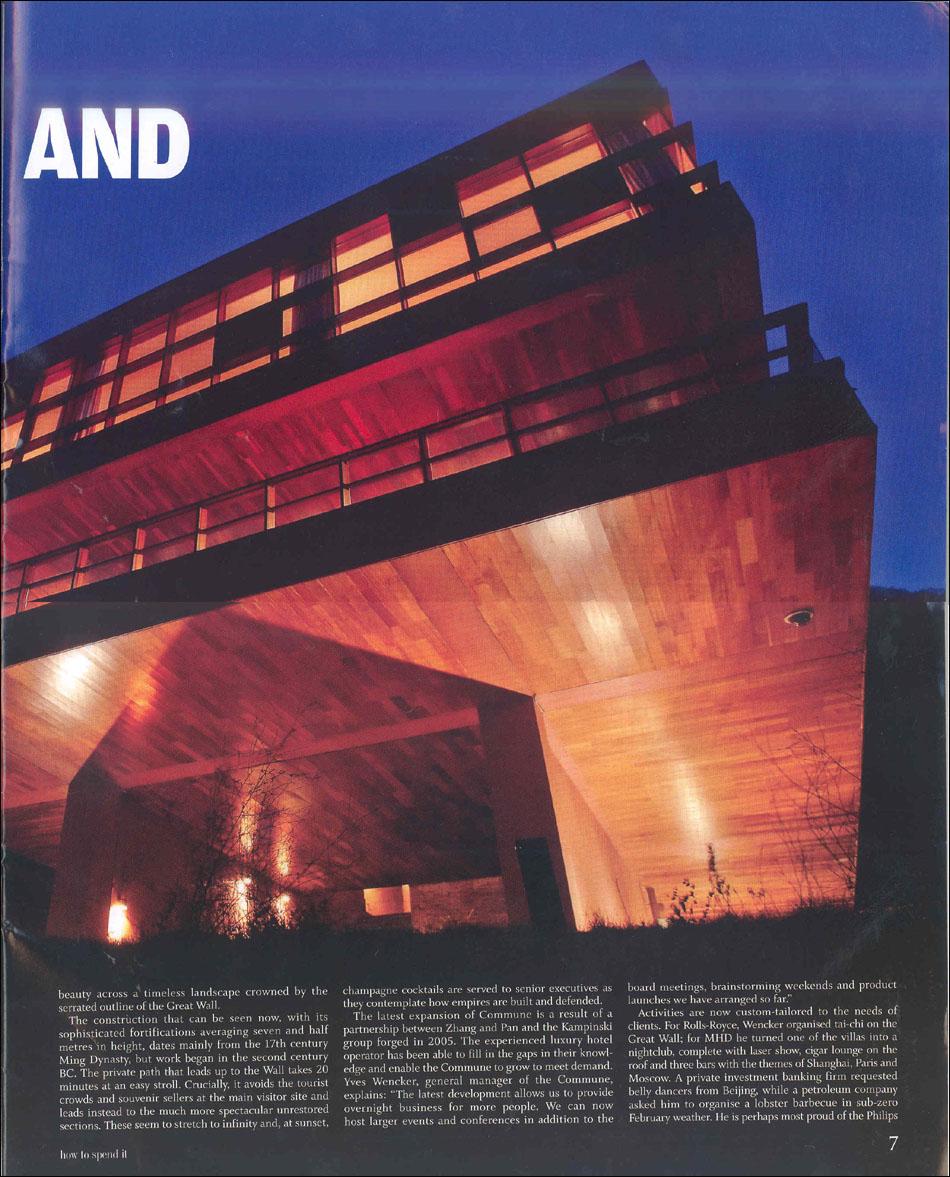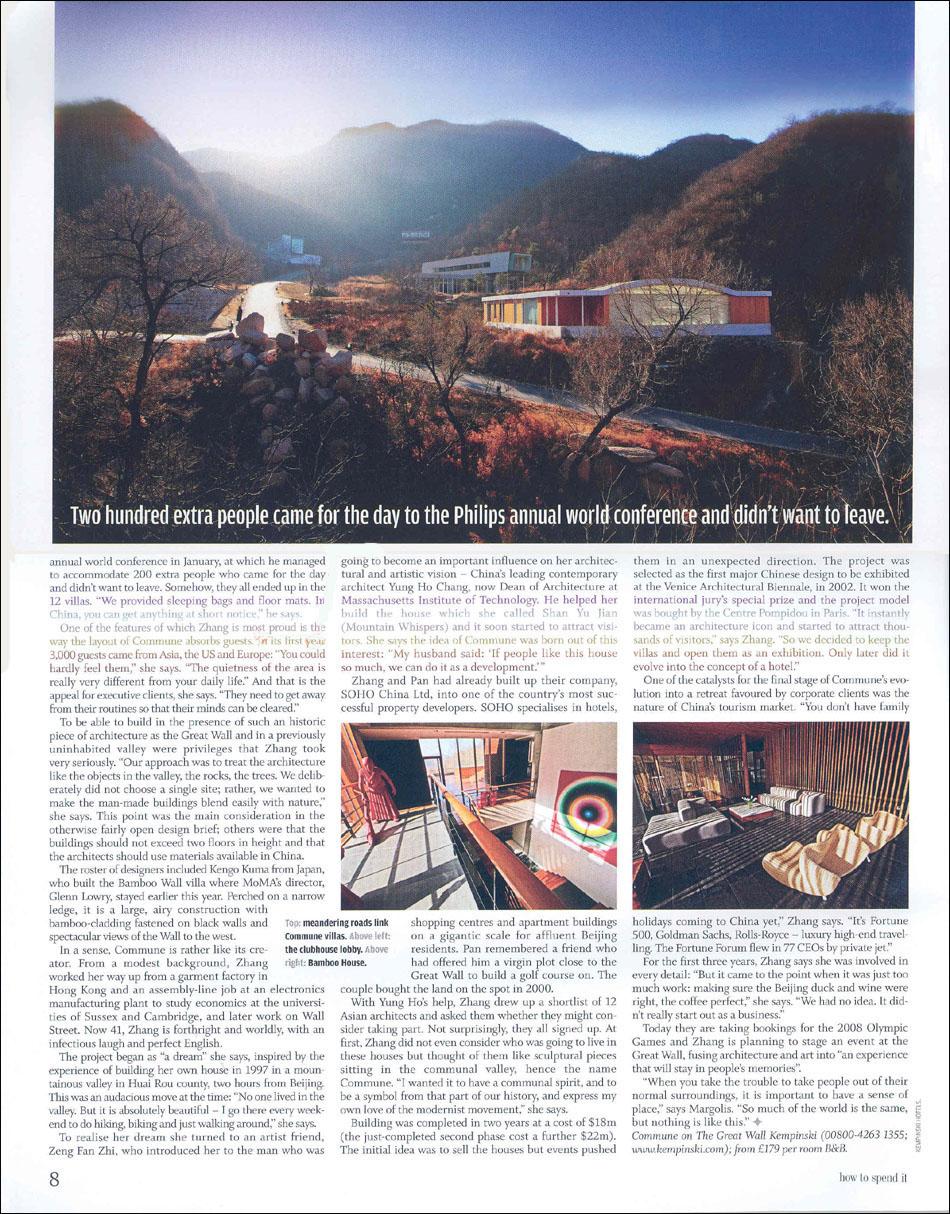



Less than an hour's drive from the buzz of Beijing is the first luxury resort to be built along China's Great Wall. And corporate guests seeking detachment from the real world are queuing up to sign the visitors'book,says Bettina von Hase.
China's Great Wall has stood as a symbol of defiance against barbarian hordes and their foreign ways for more than two millennia. Now a breach has appeared in those defences,a striking exploration of architecture that,like the Wall,clings to the contours of the land and where,instead of a clash of cultures,West can meet East in peaceful contemplation.
Commune on the Great Wall Kempinski is the first luxury resort to be built along the Wall's 6,700km length and is the creation of Chinese property developer Zhang Xin and her husband and business partner Pan Shiyi.It is located in the Badaling mountains,less than an hour's drive north of Beijing and even closer to one of the most popular visitor points on the Wall.Yet,thanks to visionary design,it has achieved a sense of detachment and peace that has already entranced an impressive list of corporate clients.There they have found a calm platform from which to reflect on China's teeming opportunities and their own place in the commercial cosmos.
Opened in 2002 as a collection of 12 houses dotted across an isolated valley and linked to the Wall by private footpath,this concept of placing contemporary architecture and design in such an iconic location has captivated the likes of BMW,Audi,VW,Daimler-Chrysler,McKinsey,Star Alliance,Lufthansa,Timberland,Motorola,Moet Hennessy Diageo MHD and New York's Museum of Modern Art MoMA .
Rolls-Royce's chief executive Sir John Rose convened his main board meeting there last June after being introduced to Commune by his regional director for north-east Asia, Richard Margolis. "He was enchanted,"recalls Margolis of that first visit,particularly by the displays of work by an impressive roster of contemporary Chinese artists.
"Sir John is a collector of contemporary art.When we discussed the possibility of having the main board meeting in China,we tried to achieve two objectives:to find a suitably contemplative place for the board to have discussions and a more public place for events bringing together customers,government departments and other members of the business community. From the moment Sir John saw Commune,he thought it was perfect,"says Margolis.
The early popularity of Commune has propelled it into a new phase of development.In September a swathe of new villas were opened.Twenty-one are replicas of four of the most successful original designs and a further 10 are built in chalet style.The addition of a new Anantara Spa completes the evolution from an architecture-led,award-winning small hotel project to China's first luxury resort capable of meeting the needs of the world's most demanding business guests.
The grounds of the Commune now stretch over an eight square kilometer site,set on a steep slope offering views of the Great Wall to the west.Villas are linked by meandering roads and pathways which in turn lead to the central clubhouse designed by South Korean architect Seung H-Sang,who has also designed the new chalets.The clubhouse contains two restaurants,a gallery specializing in contemporary art,a shop,cinema and a library,the walls of which are festooned with peacock feathers.
A butler staffs each villa."These are not the starched English kind,"says Margolis,"but female in black,Chinese dress and incredibly enthusiastic."They arrange guests' meals and activities,starting with breakfast which,for early-birds,can be preceded by private tai-chi and qigong sessions on the roofs of the villas or on the clubhouse terrace.Lunch and dinner,chosen from the Chinese-nfluenced menus,can be served to guests either in their villas or in one of the larger spaces for bigger groups.
When not eating or taking part in a wide range of tailor-made activities,guests can relax on the clubhouse terrace. This is positioned to offer a vista of intense beauty across a timeless landscape crowned by the serrated outline of the Great Wall.
The construction that can be seen now,with its sophisticated fortifications averaging seven and half metres in height,dates mainly from the 17th century Ming Dynasty,but work began in the second century BC.The private path that leads up to the Wall takes 20 minutes at an easy stroll.Crucially,it avoids the tourist crowds and souvenir sellers at the main visitor site and leads instead to the much more spectacular unrestored sections.These seem to stretch to infinity and,at sunset,champagne cocktails are served to senior executives as they contemplate how empires are built and defended.
The latest expansion of Commune is a result of a partnership between Zhang and Pan and the Kempinski group forged in 2005. The experienced luxury hotel operator has been able to fill in the gaps in their knowledge and enable the Commune to grow to meet demand.Yves Wencker,general manager of the Commune,explains:"The latest development allows us to provide overnight business for more people.We can now host large events and conferences in addition to the board meetings,brainstorming weekends and product launches we have arranged so far."
Activities are now custom-tailored to the needs of clients.For Rolls-Royce,Wencker organised tai-chi on the Great Wall;for MHD he turned one of the villas into a nightclub,complete with laser show,cigar lounge on the roof and three bars with the themes of Shanghai,Paris and Moscow.A private investment banking firm requested belly dancers from Beijing,while a petroleum company asked him to organize a lobster barbecue in sub-zero February weather.He is perhaps most proud of the Philips annual world conference in January,at which he managed to accommodate 200 extra people who came for the day and didn't want to leave.Somehow,they all ended up in the 12villas."We provided sleeping bags and floor mats.In China,you can get anything at short notice," he says.
One of the features of which Zhang is most proud is the way the layout of Commune absorbs guests.In its first year 3000 guests came from Asia,the US and Europe:"You could hardly feel them,"she says."The quietness of the area is really very different from your daily life.And that is the appeal for executive clients,she says."They need to get away from their routines so that their minds can be cleared."
To be able to build in the presence of such an historic piece of architecture as the Great Wall and in a previously uninhabited valley were privileges that Zhang took very seriously."Our approach was to treat the architecture like the objects in the valley,the rocks,the trees.We deliberately did not choose a single site;rather,we wanted to make the man-made buildings blend easily with nature,"she says.This point was the main consideration in the otherwise fairly open design brief;others were that the buildings should not exceed two floors in height and that the architects should use materials available in China.
The roster of designers included Kengo Kuma from Japan,who built the Bamboo Wall villa where MoMA's director,Glenn lowry,stayed earlier this year.Perched on a narrow ledge,it is a large,airy construction with bamboo-cladding fastened on black walls and spectacular views of the Wall to the west.
In a sense,Commune is rather like its creator.From a modest background,Zhang worked her way up from a garment factory in Hong Kong and an assembly-line job at an electronics manufacturing plant to study economics at the universities of Sussex and Cambridge,and later work on Wall Street.Now 41,Zhang is forthright and worldly,with an infectious laugh and perfect English.
The project began as "a dream" she says,inspired by the experience of building her own house in 1997 in a mountainous valley in Huai Rou count,two hours from Beijing.This was an audacious move at the time:"No one lived in the valley.But it is absolutely beautiful-I go there every weekend to do hiking,biking and just walking around," she says.
To realize her dream she turned to an artist friend Zeng Fan Zhi,who introduced her to the man who was going to become an important influence on her architectural and artistic vision-China's leading contemporary architect Yung Ho Chang,now Dean of Architecture at Massachusetts Institute of Technology.He helped her build the house which she called Shan Yu Jian Mountain Whispers and it soon started to attract visitors.She says the idea of Commune was born out of this interest:"My husband said:'if people like this house so much,we can do it as a development.'"
Zhang and Pan had already built up their company SOHO China Ltd,into one of the country's most successful property developers.SOHO specializes in hotels,shopping centres and apartment buildings on a gigantic scale for affluent Beijing residents.Pan remembered a friend who had offered him a virgin plot close to the Great Wall to build a golf course on.The couple bought the land on the spot in 2000.
With Yung Ho's help,Zhang drew up a shortlist of 12 Asian architects and asked them whether they might consider taking part.Not surprisingly,they all signed up.At first,Zhang did not even consider who was going to live in these houses but thought of them like sculptural pieces sitting in the communal valley,hence the name Commune."I wanted it to have a communal spirit,and to be a symbol from that part of our history,and express my own love of the modernist movement,"she says.
Building was completed in two years at a cost of $18m the just-completed second phase cost a furthe $22m .The initial idea was to sell the houses but events pushed them in an unexpected direction.The project was selected as the first major Chinese design to be exhibited at the Venice Architectural Biennale,in 2002.It won the international jury's special prize and the project model was bought by the Centre Pompidou in Paris."It instantly became an architecture icon and started to attract thousands of visitors,"says Zhang."So we decided to keep the villas and open them as an exhibition.Only later did it evolve into the concept of a hotel."
One of the catalysts for the final stage of Commune's evolution into a retreat favoured by corporate clients was the nature of China's tourism market."You don't have family holidays coming to China yet,"Zhang says."It's Fortune 500,Goldman Sachs,Rolls-Royce-Luxury high-end traveling.The Fortune Forum flew in 77 CEOs by private jet."
For the first three years,Zhang says she was involved in every detail:"But it came to the point when it was just too much work:making sure the Beijing duck and wine were right,the coffee perfect,"she says."We had no idea.It didn't really start out as a business."
Today they are taking bookings for the 2008 Olympic Games and Zhang is planning to stage an event at the Great Wall,fusing architecture and art into "an experience that will stay in people's memories."
"when you take the trouble to take people out of their normal surroundings,it is important to have a sense of place,"says Margolis."So much of the world is the same,but nothing is like this."
Commune on The Great Wall Kempinski 00800-4263 1355;www.kempinski.com ;from 179 per room B&B.





